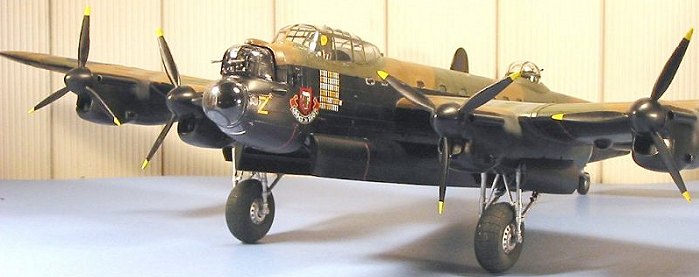
Tamiya 1/48 Lancaster I/III
|
KIT # |
MA 20 |
|
PRICE: |
$ OOP |
|
DECALS: |
See review |
|
REVIEWER: |
|
|
NOTES: |
Can be found from $25 to $100 at swap meets. |

|
HISTORY |
As William Green put it: "Many aeroplanes of the Second World War became famous; few were truly great. Greatness is a quality that cannot be instilled in an aircraft on the drawing board or the assembly line. A great aircraft must have that touch of genius which transcends the good, and it must have luck - the luck to be in the right place at the right time. It must have flying qualities above the average; reliability, ruggedness and fighting ability, and, in the final analysis, it needs the skilled touch of crews to whom it has endeared itself. All these things the Lancaster had in good measure."
The Avro Lancaster, the backbone of the British strategic bombing offensive of Germany from its appearance in 1942 to the end of the war, is one of the six most important Allied aircraft of the war - the others being the Hurricane, the Spitfire, the P-51 Mustang, the B-17 and the B-29 - aircraft for which - had they not existed - the outcome of the war might well have been different. As with many of the most useful aircraft of the war, it did not spring to life in answer to an official specification, but was rather the result of the manufacturer's decision to take what appeared to be a good design that was obviously hobbled by a terrible official specification, and "get it right."
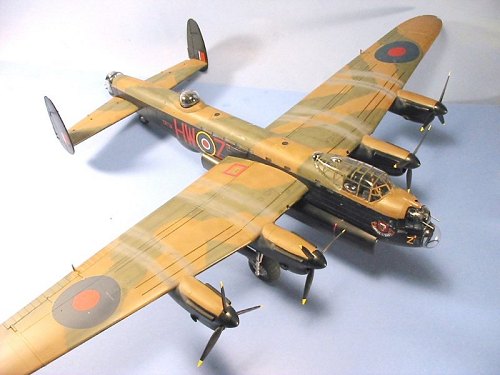 The Lancaster, like
the Phoenix, arose from the ashes to ascend to the pinnacle of greatness. In
the specific case, the ashes were the program that had produced the Avro
Manchester, which was the result of specification P.13/36, calling for a twin-engined
medium bomber; this resulted in two designs - the Handley-Page H.P.56 which
eventually resulted in the Halifax, and the Avro 679, which was the
Manchester.
The Lancaster, like
the Phoenix, arose from the ashes to ascend to the pinnacle of greatness. In
the specific case, the ashes were the program that had produced the Avro
Manchester, which was the result of specification P.13/36, calling for a twin-engined
medium bomber; this resulted in two designs - the Handley-Page H.P.56 which
eventually resulted in the Halifax, and the Avro 679, which was the
Manchester.
The Manchester was robbed of any chance of successfully achieving the design specification when it was saddled with the 24-cylinder X-type Rolls-Royce Vulture as its powerplant. The first prototype, L7246, flew on July 25, 1939. The first Manchester was delivered to 207 Squadron in December, 1940, and made its operational debut with a raid on Brest the night of February 24-25, 1941. Failure of the Manchester was due to the inability of Rolls-Royce to cure the teething problems of the Vulture engine, which proved completely unreliable in service.
Avro produced only 169 Manchester I and IA aircraft, with Metro-Vickers producing an additional 43.
Due to the engine problems, Avro proposed the Manchester II, powered by either two Bristol Centaurus or two Napier Sabre engines, and the Manchester III, which would be powered by four Rolls-Royce Merlins. This last proposal would result in the Lancaster. Use of the basic Manchester airframe allowed the prototype Lancaster to take to the air on January 9, 1941. Apart from a new wing center section to take the four Merlins, the rest of the airplane was virtually identical with the Manchester. The Air Staff enthusiastically ordered the Lancaster into mass production in February 1941, following successful flight trials, with the first production Lancaster flying on October 31, 1941.
44 Squadron undertook the first operational mission with the Lancaster on March 3, 1942, a mine-laying sortie in the Heligoland Bight. Public existence of the Lancaster was revealed following the low-level daylight attack made by twelve Lancasters of 44 and 97 Squadrons against the Maschinenfabrik-Augsburg-Nuremberg, which produced diesel engines for U-boats. Of the 12 aircraft, only five returned to base, though the target was heavily damaged. Squadron Leader Nettleton of 44 Squadron was awarded the Victoria Cross for this mission - the first of nine awards of the VC that would go to Lancaster crew during the war.
 The basic Lancaster
design was so right that the three different mark numbers associated with it
refer only to engine changes: the Mk. I used the Merlin XX and 22; the Mk.II
used the Bristol Hercules; and the Mk. III used the American Packard-built
Merlin 28, 38, and 224. The Lancaster was also produced as the Mk.X in Canada,
where the production of 433 examples of such a large and complex aircraft was
largely responsible for the creation of the modern Canadian aircraft
industry.
The basic Lancaster
design was so right that the three different mark numbers associated with it
refer only to engine changes: the Mk. I used the Merlin XX and 22; the Mk.II
used the Bristol Hercules; and the Mk. III used the American Packard-built
Merlin 28, 38, and 224. The Lancaster was also produced as the Mk.X in Canada,
where the production of 433 examples of such a large and complex aircraft was
largely responsible for the creation of the modern Canadian aircraft
industry.
By 1943, the Lancaster equipped the majority of Bomber Command units. It was in late 1943 that the aircraft was first equipped with the H2S centimetric radar. This equipment went a long way toward allowing crews to find their targets, but using it was like turning on a flashlight in a darkened room, due to the fact that the Germans were able to develop a homing device quickly, following the retrieval of an H2S set from a crashed Lancaster. What is truly criminal is that Air Marshal Harris and the command staff of Bomber Command were aware of this German capability, but never told the crews that they drew the fighters to them when they turned on the set. The story put out by Bomber Command that the apparent explosions of bombers that crews saw over Germany were "scarecrow shells" fired by German flak was a complete lie; the Germans never used such a weapon, and every mid-air explosion and fiery trail to the ground the crews saw was indeed a British bomber shot down by the night fighters or hit by flak. Of 100,000 aircrew who served in Bomber Command during the Second World War, 50,000 were killed, wounded or made prisoner. One wonders how many were lost due to this policy by their commanders.
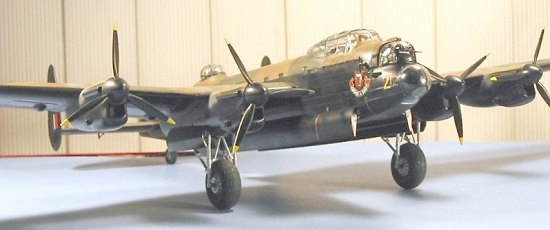 While the Lancaster
was truly amazing in its ability to carry ever-heavier weapons, it is
unfortunate that the result of the expenditure of all this vast collection of
men and material did not measure up to what was sacrificed. The men of Bomber
Command were truly "the flower of the British Empire," and they fought a
harder, more difficult, and more dangerous war than was the experience of
their American allies. The crews were fully the equal of their mount and the
two together might have been a decisive force in the outcome of the war beyond
mere destruction, had Churchill been willing to take the political heat of
firing "Bomber" Harris, OC of Bomber Command in January 1944, for gross
insubordination and disobedience - a charge that was made against him by his
American allies for his refusal to meaningfully participate in Operation
Pointblank, the bomber offensive against the Luftwaffe and the German aircraft
industry that had been determined at the Casablanca Conference in February
1943.
While the Lancaster
was truly amazing in its ability to carry ever-heavier weapons, it is
unfortunate that the result of the expenditure of all this vast collection of
men and material did not measure up to what was sacrificed. The men of Bomber
Command were truly "the flower of the British Empire," and they fought a
harder, more difficult, and more dangerous war than was the experience of
their American allies. The crews were fully the equal of their mount and the
two together might have been a decisive force in the outcome of the war beyond
mere destruction, had Churchill been willing to take the political heat of
firing "Bomber" Harris, OC of Bomber Command in January 1944, for gross
insubordination and disobedience - a charge that was made against him by his
American allies for his refusal to meaningfully participate in Operation
Pointblank, the bomber offensive against the Luftwaffe and the German aircraft
industry that had been determined at the Casablanca Conference in February
1943.
Harris' single-minded policy of the area bombing of German cities might have made sense in 1942 when he was given command - in those days 80 percent of British bombers did not drop their bombs within 10 miles of their target, due to their inability to successfully navigate over Germany by night. By January 1944, Harris had lost nearly 400 of the 600 bombers he would lose in the "Battle of Berlin" that was finally called off in March 1944 when General Eisenhower was given direct control of the Allied strategic bombing forces in preparation for the coming invasion. Throughout his career, Harris would have no truck with "panacea merchants," his term for individuals in and out of the RAF who disagreed with his strategy and repeatedly tried to direct the bomber offensive against specific industries.
When Bomber
Command, along with the 8th Air Force, finally went after the German synthetic
oil industry in the summer of 1944 - missions Harris only took on after the
greatest resistance he could mount against them - the strategic bombers
finally had a real and serious effect on the enemy worthy of the effort to
field them. The ability to find and strike these plants had existed within
Bomber Command for a year prior to the missions being flown. Had the
synthetic oil industry been hit in late 1943 the way it was hit in July and
August 1944, the bomber baron's belief that they could decisively defeat the
Germans to the point where Allied troops would walk ashore in the invasion
might actually have happened. The strikes of the summer of 1944 - which were
strangely not followed 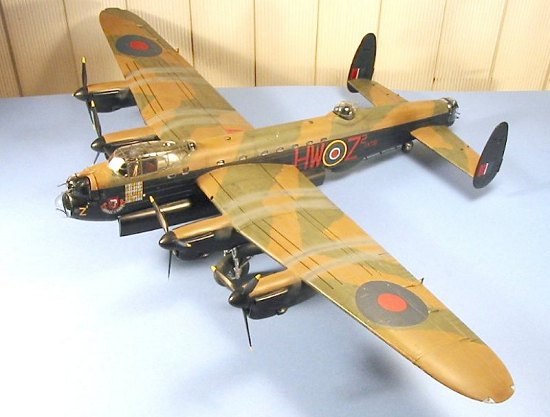 up
for several months, despite immediate knowledge of both their effectiveness
and their impact on German war-fighting abilities - practically grounded the
Luftwaffe and stopped the Panzers on all fronts for lack of fuel. Harris
persisted in his "morale bombing" to the end, making him the most obvious of
the failed disciples of Air Marshal Trenchard's adoption of the so-called
"theories of air warfare" advanced by Giulio Douhet.
up
for several months, despite immediate knowledge of both their effectiveness
and their impact on German war-fighting abilities - practically grounded the
Luftwaffe and stopped the Panzers on all fronts for lack of fuel. Harris
persisted in his "morale bombing" to the end, making him the most obvious of
the failed disciples of Air Marshal Trenchard's adoption of the so-called
"theories of air warfare" advanced by Giulio Douhet.
As Max Hastings has pointed out in his terrific history, "Bomber Command": "The morale of the German people remained unbroken to the end, despite growing awareness that the war must be lost, and despite the increasing indifference of their Fuehrer to their fate... even in the ruined cities people queued to pay their taxes at temporary offices. After Big Week in February 1944, Speer and Milch marveled at the manner in which the aircraft workers labored in open assembly lines created in the open air in freezing weather, the heated factories having been reduced to rubble. They repaired damage, restored production - even made their own shattered homes somehow habitable - with less assistance than the British authorities had provided for their own people during the Blitz. What was done in Germany between 1942 and 1944 was not an economic miracle - Speer was extremely able but he was not a genius. It was a triumph of the German people in the face of the utmost suffering, paralleling that of the British in 1940 and 1941. The assumption upon which the RAF had built its area-bombing campaign, that Germans were liable to moral collapse in a way that the British had shown in 1940 that they were not, had been proven totally unfounded."
In 1946, after
reading the report of the U.S. Strategic Bombing Survey, Albert Speer recorded
in his "Secret Diaries": "It seems to me that the book misses the decisive
point. Like all other accounts of the bombing that I have so far seen, it
places its emphasis on the destruction that air raids inflicted on German
industrial potential and thus upon armaments. In reality, the losses were not
quite so serious. The real importance of the air war consisted in the fact
that it opened a second front long before the invasion of Europe. That front
was the skies over Germany. The unpredictability of the attacks made the
front gigantic. Defense against air attacks required the production of
thousands of anti-aircraft guns, the stockpiling of tremendous quantities of
ammunition all over the country, and holding in readiness hundreds of
thousands of soldiers. As far as I can judge from the accounts I have read,
no one has yet seen that this was the greatest lost battle on the German
side." Later, in his book "Inside The Third Reich," Speer reasserted the view
he had taken during his post-war interrogations, that bombing had been
ineffective in 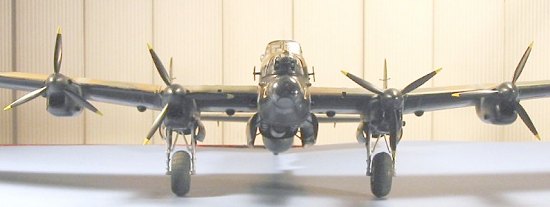 cracking
Germany until the closing phase of the war when the synthetic fuels industry
was attacked and destroyed.
cracking
Germany until the closing phase of the war when the synthetic fuels industry
was attacked and destroyed.
The Lancaster and its crews may have been ill-served by a lack of vision on the part of their commander, but in that no way minimizes the accomplishments of the crews and their airplane against difficult odds in a terrible and dangerous battlefield. The Lancaster is truly deserving of its reputation as one of the greatest airplanes ever built, and its crews as being among the bravest.
For anyone wanting to learn more of the operational history of the Lancaster and its crews in the war they fought, I cannot recommend too highly Max Hastings' "Bomber Command," one of the best-written and most informative history books it has ever been my pleasure to read and re-read. It is now out of print, but available on-line.
|
THE KIT |
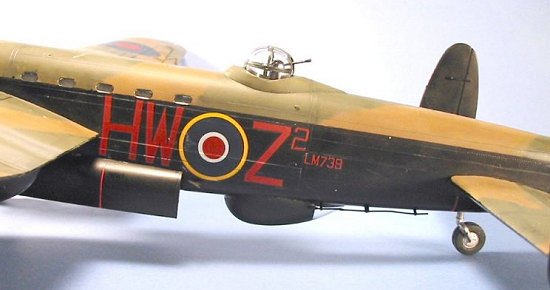 Tamiya's big
Lancaster first appeared in the early 1970s. The first time I recall seeing
one built at a show was (I think) in 1974. It was an impressive model, and
still is today. Even now, produced at a price approaching US$100, and turned
into a toy by Tamiya's decision to equip it with electric motors to spin the
props, it is still good value and unlikely to ever be bettered - at least by a
price less than what one used to pay for a new car!
Tamiya's big
Lancaster first appeared in the early 1970s. The first time I recall seeing
one built at a show was (I think) in 1974. It was an impressive model, and
still is today. Even now, produced at a price approaching US$100, and turned
into a toy by Tamiya's decision to equip it with electric motors to spin the
props, it is still good value and unlikely to ever be bettered - at least by a
price less than what one used to pay for a new car!
The combination of raised and recessed surface detail on the kit is accurate, since the airplane itself was not as smooth and sleek as some modelers seem to think all airplanes are supposed to be. Interior detail is sufficient that one can build an acceptable model straight out of the box. However, there are areas of the cockpit that can be seen through the huge clear canopy that cry out for a little bit of extra work, none of which is beyond the ability of an average modeler.
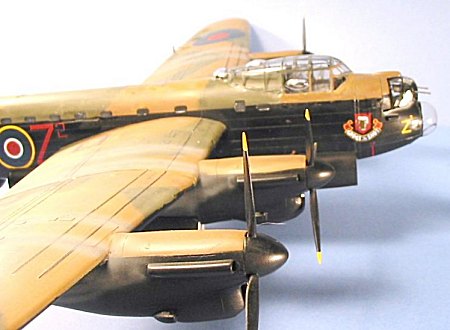 As it comes in the
box, the model is an early-production aircraft - as revealed by the smaller
bombardier's Perspex dome - with late-production paddle props. In fact,
calling these two items "early production" and "late production" is a bit of a
misnomer, since in fact an early-production airplane might later be equipped
with late-production props, and even late-production airplanes might be
equipped with "early production" narrow-chord propellers. Once the larger
Perspex dome became available, it too was retrofitted. Fortunately, Falcon
Vacuforms include the enlarged dome in their Canopy Set Number 40.
As it comes in the
box, the model is an early-production aircraft - as revealed by the smaller
bombardier's Perspex dome - with late-production paddle props. In fact,
calling these two items "early production" and "late production" is a bit of a
misnomer, since in fact an early-production airplane might later be equipped
with late-production props, and even late-production airplanes might be
equipped with "early production" narrow-chord propellers. Once the larger
Perspex dome became available, it too was retrofitted. Fortunately, Falcon
Vacuforms include the enlarged dome in their Canopy Set Number 40.
The kit decals provide markings for the famous S-Sugar, which flew more missions than any other Lancaster during the war, as well as four other aircraft. The red in the markings and insignias is far too bright, however, for wartime insignia. Fortunately, there are several aftermarket decal sheets for the Lancaster.
The kit betrays its 1970s origins in the fact that it doesn't fit like a Tamiya kit fits today. I had the good luck to obtain an original-run kit with a copyright date of 1973 from Dave Yodens last year, for a price that was more than reasonable. This was the first original-run kit I had built, and while it was better than the two early-90s kits I have made, at least in terms of mold quality, it still presented problems that a modeler assembling a contemporary kit will not confront.
|
CONSTRUCTION |
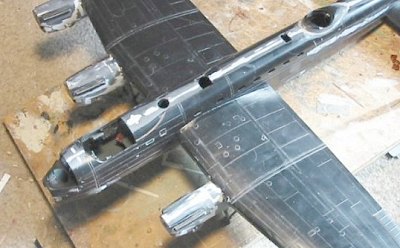 Since test-fitting
had revealed how poorly the engine nacelles fit, I started with these. After
assembly, gaps were filled with cyanoacrylate glue, then the differences
between parts was dealt with with putty. Once I had smooth structures, they
were covered with Mr. Surfacer, and sanded down to final shape. I then
rescribed all panel lines.
Since test-fitting
had revealed how poorly the engine nacelles fit, I started with these. After
assembly, gaps were filled with cyanoacrylate glue, then the differences
between parts was dealt with with putty. Once I had smooth structures, they
were covered with Mr. Surfacer, and sanded down to final shape. I then
rescribed all panel lines.
I assembled the upper parts of the landing gear that fit into the wheel wells, assembled the wheel wells into the wings, and attached the engine nacelles. I again had to fill gaps where the nacelles attached to the wing with cyanoacrylate glue. I was trying very hard to use the minimum, to avoid losing the very good surface detail on the wings, and was largely successful with that.
I decided when it
came to assembly of the fuselage that "if you can't
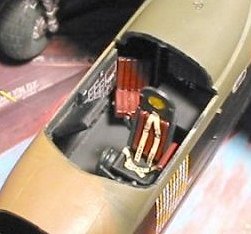 see it, I'm not going to
do it. I concentrated on improving the area of the pilot's seat, adding on
the trim wheel, and scratch-building the throttle handles. The entire
interior from the navigator's position forward was painted flat black, whic
see it, I'm not going to
do it. I concentrated on improving the area of the pilot's seat, adding on
the trim wheel, and scratch-building the throttle handles. The entire
interior from the navigator's position forward was painted flat black, whic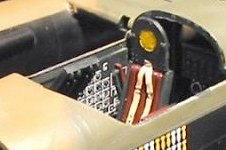 h
was done on all late-production Lancasters and to many early ones that had
first been painted British Interior Green. I picked out details with
drybrushed flat aluminum, and used the kit instrument panel decals. I finished
off with a set of Cutting Edge posable resin seat belts for the pilot's seat,
which vastly improved the final look.
h
was done on all late-production Lancasters and to many early ones that had
first been painted British Interior Green. I picked out details with
drybrushed flat aluminum, and used the kit instrument panel decals. I finished
off with a set of Cutting Edge posable resin seat belts for the pilot's seat,
which vastly improved the final look.
All the glass was
dipped in Future before I used it. The turret interiors were improved in
accordance with an article that had appeared in an old issue of Scale Aviation
Modeling that Dave Yodens had included with the kit. The central glass panel
of the rear turret was cut out and removed; on the real airplanes, this
allowed the rear gunner to have clearer vision at
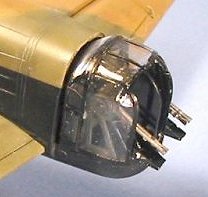 night, which was
frequently the margin that allowed him to spot an approaching night fighter in
time to warn the pilot to take defensive action.
night, which was
frequently the margin that allowed him to spot an approaching night fighter in
time to warn the pilot to take defensive action.
For the particular Lancaster that I was doing, there were none of the side windows from the leading edge of the wing aft. Therefore, I attached the clear plastic window parts, then carefully filled them in with additional putty, which was then carefully sanded down with a minimum loss of surface detail, which was rescribed where necessary. The fuselage centerline seam was pretty big, but careful sanding down of the joint on the unassembled parts before assembly, and then judicious use of cyanoacrylate glue to fill the gap resulted again in a minimum loss of surface detail in losing the seam. I then attached the canopy, and filled in the gap between canopy and fuselage with more cyanoacrylate glue.
I then assembled wings and tails to fuselage, and was ready for the paint shop.
|
CAMOUFLAGE & MARKINGS |
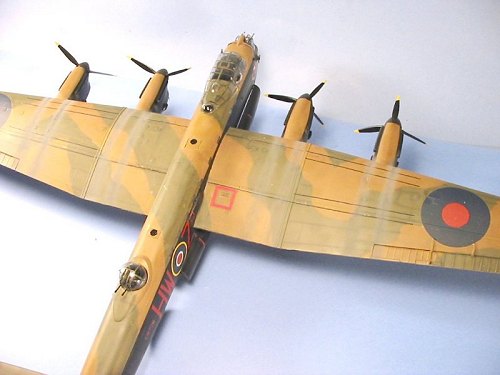 Painting:
Painting:
I first painted the upper camouflage, using Gunze-Sangyo Dark Earth and RAF Dark Green, then "faded" each color with some Gunze-Sangyo "Violet" to simulate high-altitude sun-fading. The particular airplane I was doing was built in September 1944, and took part in all of the RAF's daylight missions between then and the end of the war, so I figured there had been some operational sun-fading that a pure night bomber would not have experienced.
Once this was complete, I Futured the upper surfaces and masked them off. The rest of the model was painted with Tamiya Semi-gloss Black.
The landing gear was painted aluminum, hand-brushing those parts that were already inside the wheel wells.
Decals:
I used an older
aftermarket sheet Dave Yodens had
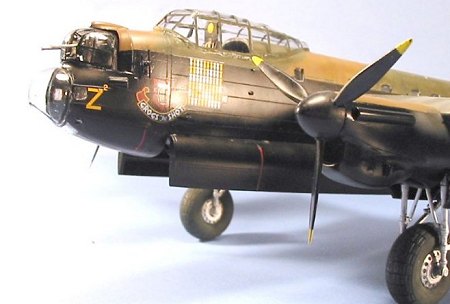 thoughtfully provided me,
to build "Grog's the Shot," which led the last Bomber Command daylight raid of
the war, the bombing of Hitler's "Eagle's Nest" at Berchtesgaden on April 22,
1945. These went down under repeated assault waves of Micro-Sol. I used the
stenciling from a Techmod sheet of Lancaster markings. I had planned to use
the national insignia's from this sheet, but they broke apart when I attempted
to slide them off the paper.
thoughtfully provided me,
to build "Grog's the Shot," which led the last Bomber Command daylight raid of
the war, the bombing of Hitler's "Eagle's Nest" at Berchtesgaden on April 22,
1945. These went down under repeated assault waves of Micro-Sol. I used the
stenciling from a Techmod sheet of Lancaster markings. I had planned to use
the national insignia's from this sheet, but they broke apart when I attempted
to slide them off the paper.
|
FINAL CONSTRUCTION |
I painted the upper camouflage with thinned Dullcote, while leaving the semi-gloss black alone. I painted the exhaust staining with Tamiya Neutral Grey, following that with thinned Tamiya Nato Brown, with final application of Tamiya Smoke.
The turrets were glued in position and the propellers and main gear were attached. I used the Falcon large Perspex dome.
|
CONCLUSIONS |
The Tamiya Lancaster is an impressive kit that builds into an impressive model. It is unlikely to ever be bettered, and is a worthy candidate for inclusion in your collection even if you have to pay collectors prices. Thanks to Dave Yodens for not charging what he could have gotten on Ebay.
April 2003
Copyright ModelingMadness.com. All rights reserved. No reproduction in part or in whole without express permission from the editor.
If you would like your product reviewed fairly and quickly, please contact the editor or see other details in the Note to Contributors.